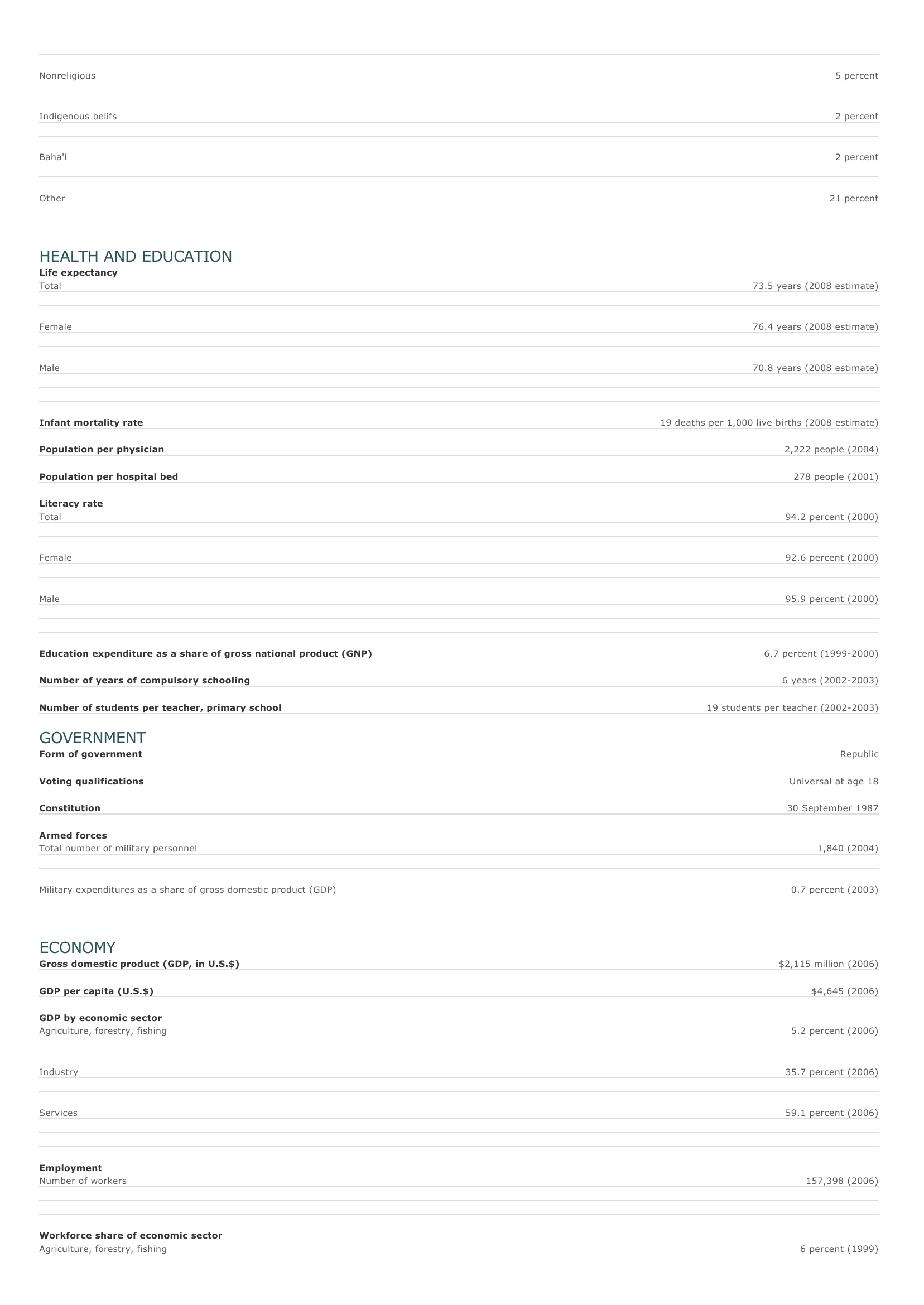Suriname Facts and Figures. BASIC FACTS Official name Capital Area Republic of Suriname Paramaribo 163,265 sq km 63,037 sq mi PEOPLE Population 475,996 (2008 estimate) Population growth Population growth rate 1.10 percent (2008 estimate) Projected population in 2025 560,061 (2025 estimate) Projected population in 2050 617,249 (2050 estimate) Population density 2.9 persons per sq km (2008 estimate) 7.5 persons per sq mi (2008 estimate) Urban/rural distribution Share urban 77 percent (2005 estimate) Share rural 23 percent (2005 estimate) Largest cities, with population Paramaribo 253,000 (2003 estimate) Lelydorp 15,600 (1996 estimate) Nieuw Nickerie 11,100 (1996 estimate) Ethnic groups Hindustani (descendants of immigrants from northern India) 37 percent Creole (mixed European and African) 31 percent Indonesian 15 percent Maroon (descendants of escaped African slaves) 10 percent Native American 3 percent Chinese 2 percent European, other 2 percent Languages Dutch (official), English, Sranang Tongo (Surinamese or Taki-Taki), Hindustani, Chinese, French, Spanish, Javanese Religious affiliations Roman Catholic 23 percent Hindu 18 percent Protestant (predominantly Moravian) 17 percent Muslim 14 percent Nonreligious 5 percent Indigenous belifs 2 percent Baha'i 2 percent O ther 21 percent HEALTH AND EDUCATION Life expectancy Total 73.5 years (2008 estimate) Female 76.4 years (2008 estimate) Male 70.8 years (2008 estimate) Infant mortality rate Population per physician Population per hospital bed 19 deaths per 1,000 live births (2008 estimate) 2,222 people (2004) 278 people (2001) Literacy rate Total 94.2 percent (2000) Female 92.6 percent (2000) Male 95.9 percent (2000) Education expenditure as a share of gross national product (GNP) Number of years of compulsory schooling Number of students per teacher, primary school 6.7 percent (1999-2000) 6 years (2002-2003) 19 students per teacher (2002-2003) GOVERNMENT Form of government Republic Voting qualifications Universal at age 18 Constitution 30 September 1987 Armed forces Total number of military personnel Military expenditures as a share of gross domestic product (GDP) 1,840 (2004) 0.7 percent (2003) ECONOMY Gross domestic product (GDP, in U.S.$) GDP per capita (U.S.$) GDP by economic sector Agriculture, forestry, fishing $2,115 million (2006) $4,645 (2006) 5.2 percent (2006) I ndustry 35.7 percent (2006) Services 59.1 percent (2006) Employment Number of workers Workforce share of economic sector Agriculture, forestry, fishing 157,398 (2006) 6 percent (1999) I ndustry 15 percent (1999) Services 75 percent (1999) Unemployment rate 13.8 percent (1999) National budget (U.S.$) Total revenue $300 million (1994 estimate) Total expenditure $700 million (1994 estimate) Monetary unit 1 Suriname dollar (SRD), consisting of 100 cents Major trade partners for exports United States, Norway, France, Netherlands, and Canada Major trade partners for imports United States, China, Netherlands, Trinidad and Tobago, and Netherlands Antilles ENERGY, COMMUNICATIONS, AND TRANSPORTATION Electricity production Electricity from thermal sources 25.02 percent (2003 estimate) Electricity from hydroelectric sources 74.98 percent (2003 estimate) Electricity from nuclear sources 0 percent (2003 estimate) Electricity from geothermal, solar, and wind sources 0 percent (2003 estimate) Number of radios per 1,000 people 728 (1997) Number of telephones per 1,000 people 180 (2005) Number of televisions per 1,000 people 253 (2000 estimate) Number of Internet hosts per 10,000 people Daily newspaper circulation per 1,000 people Number of motor vehicles per 1,000 people Paved road as a share of total roads 0.34 (2003) 68 (1998) 238 (2004) 26 percent (2003) SOURCES Basic Facts and People sections Area data are from the statistical bureaus of individual countries. Population, population growth rate, and population projections are from the United States Census Bureau, International Programs Center, International Data Base (IDB) (www.census.gov). Urban and rural population data are from the Food and Agriculture Organization (FAO) of the United Nations (UN), FAOSTAT database (www.fao.org). Largest cities population data and political divisions data are from the statistical bureaus of individual countries. Ethnic divisions and religion data are largely from the latest Central Intelligence Agency (CIA) World Factbook and from various country censuses and reports. Language data are largely from the Ethnologue, Languages of the World, Summer Institute of Linguistics International (www.sil.org). Health and Education section Life expectancy and infant mortality data are from the United States Census Bureau, International Programs Center, International database (IDB) (www.census.gov). Population per physician and population per hospital bed data are from the World Health Organization (WHO) (www.who.int). Education data are from the United Nations Educational, Scientific and Cultural Organization (UNESCO) database (www.unesco.org). Government section Government, independence, legislature, constitution, highest court, and voting qualifications data are largely from various government Web sites, the latest Europa World Yearbook, and the latest Central Intelligence Agency (CIA) World Factbook. The armed forces data is from Military Balance. Economy section Gross domestic product (GDP), GDP per capita, GDP by economic sectors, employment, and national budget data are from the World Bank database (www.worldbank.org). Monetary unit, agriculture, mining, manufacturing, exports, imports, and major trade partner information is from the statistical bureaus of individual countries, latest Europa World Yearbook, and various United Nations and International Monetary Fund (IMF) publications. Energy, Communication, and Transportation section Electricity information is from the Energy Information Administration (EIA) database (www.eia.doe.gov). Radio, telephone, television, and newspaper information is from the United Nations Educational, Scientific and Cultural Organization (UNESCO) database (www.unesco.org). Internet hosts, motor vehicles, and road data are from the World Bank database (www.worldbank.org). Note Figures may not total 100 percent due to rounding. Microsoft ® Encarta ® 2009. © 1993-2008 Microsoft Corporation. All rights reserved.









